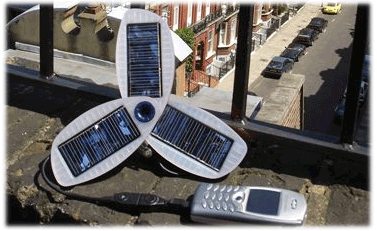





|
|
|
|

Solio Solar Charger
User tips
"I am serious about solar charging so what details do I need to know?"
-
Batteries - Changes in temperature and humidity affect battery efficiency, so extreme weather conditions may hinder the ability of your electronic devices to function effectively. The charging temperature range for a lithium-ion battery is 0° - 45° C (32° - 113° F), and the batteries can be discharged at temperatures of 20° - 50° C (68° - 122° F). In case of extreme temperatures, keep your battery-using device from getting too hot or too cold.
-
Humidity and Salt - Coastal regions of high humidity are notorious for their effects on electrical devices and systems. If you are in a tropical coastal region for prolonged periods of time, make sure that all electrical devices are kept dry and covered when not in use.
-
Time of Year - During the summer months, the earth’s angle of exposure to the sun is at its greatest, making the sun more powerful. Also, summer days are longer, allowing a battery to charge better. Solio’s internal battery will charge almost twice as much on the longest day of the year as on the shortest. See Solar Intensity Maps
-
Time of Day - The time of day you charge Solio influences the charge speed. At noon, when the sun is at the highest point in the sky, the maximum charge level will be obtained. Therefore, solar exposure for one hour at noon will provide greater charge than one hour at 4 p.m. on the same day. The total time of solar exposure will have a cumulative affect.
-
Orientation to the Sun - For optimum performance, Solio must face directly toward the sun. As the earth rotates, the position of the sun relative to Solio will change throughout the day. If the orientation is not corrected, the effectiveness of charging decreases. Adjustments are not necessary for slight changes. However, over a period of hours, the loss of charging efficiency can reduce greatly. The sun moves approximately 15 degrees across the sky every hour
-
Ambient Temperature - Solar cells are affected by extremes in temperature, and work within the range of 0° - 90° C (32° - 194° F) but our visits to the polar regions have proved us successful at extremes of minus 50° C. For the best performance, the maximum surface temperature of Solio should be below 50° C (122° F). Obviously, you must place the battery in the sun to charge it, so it will naturally heat up and become hotter than the air temperature. Please bear in mind that the higher the ambient temperature, the higher Solio’s temperature. Therefore, charging efficiency will be affected.
-
Solar Filters - Solar filters are objects or conditions that block the transmission of light to Solio. These may be intermittent situations—such as a passing cloud or the shadow of a building—or continuous obstructions—such as fog, air pollution, or tinted glass. Since solar electricity is primarily generated within the visible light spectrum, anything that reduces the intensity of the light reduces the charge efficiency. Since most vehicles and commercial buildings have tinted windows, charging through them will significantly or completely reduce charging efficiencies. Normal glass has a slight UV filtering effect and will reduce charging efficiencies between 5% and 10%. Dirty glass will obviously increase charging time.
-
Latitudinal Position -The strength of the sun is at its greatest along the equator. As you travel farther away from it, the intensity of the sun diminishes, decreasing the effectiveness of solar charging. See Solar Intensity Maps
General
-
When charging from the Sun do not to let any shadow cover any part of the solar panels at any time
-
From time to time, re-position Solio so it is directly facing the sun. Simply use a pencil to help position it. (See diagrams 4 & 5 in the instruction manual.)
-
Charging through a window using the Solio suction cup will increase charge times. For a maximum solar charge, angle Solio directly in line with the sun, with no obstruction.
-
To avoid damaging Solio or decreasing its effectiveness, do not place it on the dashboard of your car for long periods of time.
|
|
|
|
|
|
|